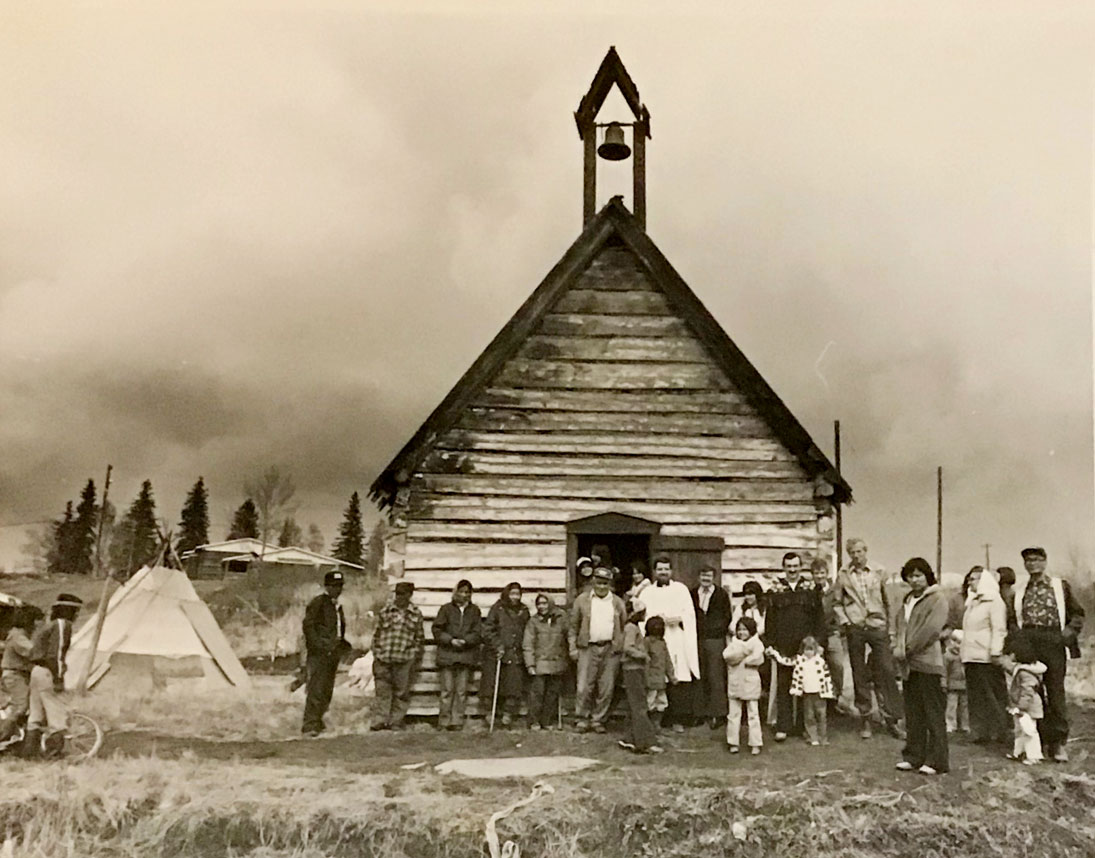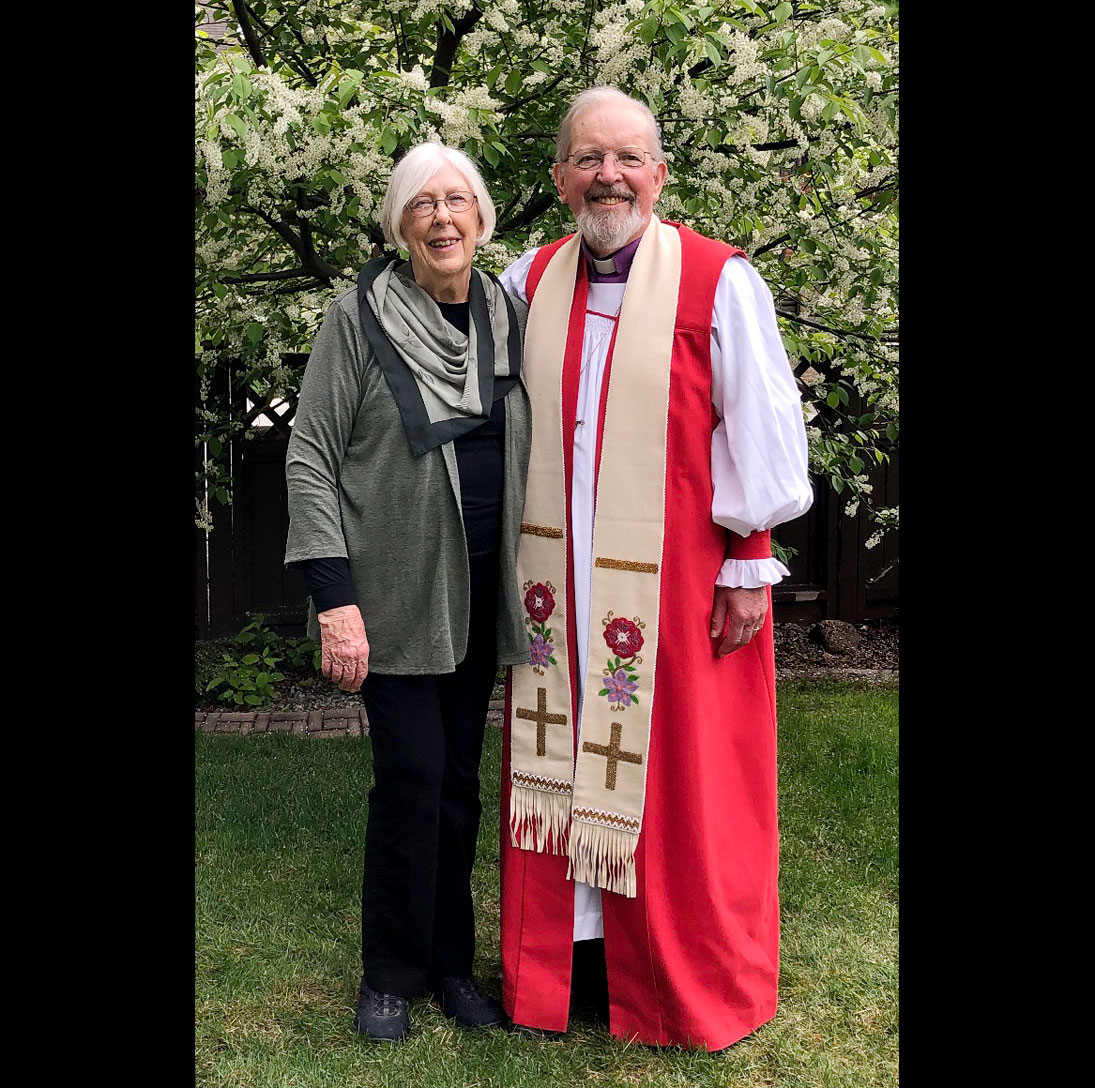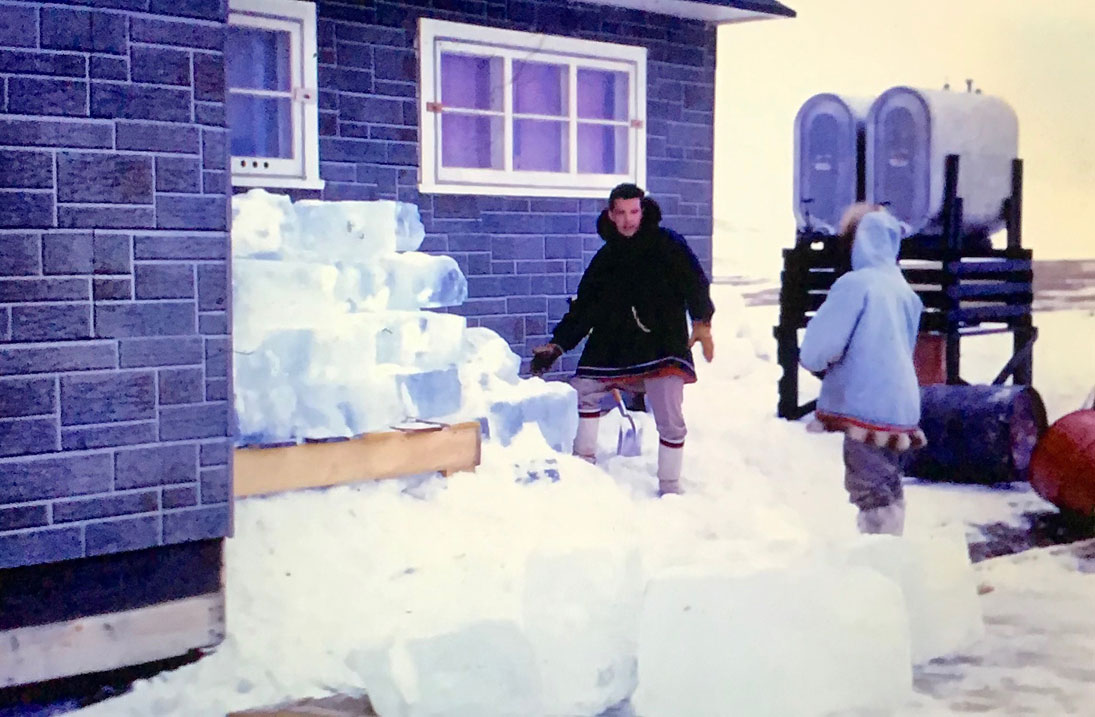
Photo by Photo Submitted
THE FORT NORMAN DAYS – Terry Buckle and members of the congregation are seen outside the old Anglican Church in Fort Norman in 1978. Photo courtesy Pam Kos

Photo by Photo Submitted
THE FORT NORMAN DAYS – Terry Buckle and members of the congregation are seen outside the old Anglican Church in Fort Norman in 1978. Photo courtesy Pam Kos

Photo by Photo Submitted
A DEVOTED COUPLE – Terry and Blanche Buckle are seen earlier this summer in Whitehorse. Photo courtesy Pam Kos

Photo by Photo Submitted
THE WATER SUPPLY – Terry Buckle stacks ice blocks for a home water supply on Holman Island. Photo courtesy Pam Kos
Ed. note: Archbishop Terry Buckle died Sept. 10, shortly after his 80th birthday. This story about him was first published in the Star on Nov. 26, 2010.
Ed. note: Archbishop Terry Buckle died Sept. 10, shortly after his 80th birthday. This story about him was first published in the Star on Nov. 26, 2010.
A true northern bishop, with a remarkable story, although Terry Buckle would be the first to say that he is just an ordinary guy, just doing what “the Boss ordered.”
Almost 45 years North of 60, dedicated to the church and most of that in the Arctic or in the Yukon, Buckle has officially retired, having reached the mandatory age of 70.
At his farewell reception in October 2010 at Christ Church Cathedral, with many friends, his four children, and his very special partner and wife, Blanche, present, he gave his remarkable story.
Born in Simcoe, Ont. into a family that was nominally Christian, he left school early, although he’d been a good student and interested in debate.
There were alcohol issues in the home, and he felt he needed to help out the family. He joined his dad and grandfather as a stone mason apprentice, laying bricks.
This job gave him a muscular build and, as an old friend recently testified, bullies were immediately disarmed by that and his good-natured smile.
He was one of the few teenagers who claimed that he enjoyed going to church and by the influence of his minister, became a server, then was asked to read and lead prayers.
Rev. Owen suggested that Buckle look into a career in the church, as he felt he had a call.
Buckle gave the matter much “on the knees prayer” and agreed with God to “give it a try,” becoming a worker for the “corner stone” of the church instead of a brick layer.
After upgrading his education, he joined the church army in 1962, serving in Ontario, then in Quebec with a four-point parish ministry and as port chaplain in Montreal and then back in 1963 to Toronto with an inner city ministry and for some courses at Wycliffe College.
Meanwhile, the cute little nine-year-old blonde girl who he met at Sunday school, called Blanche, grew up and had become his wife.
In 1966, he was then asked to work under Archdeacon John Sperry on Holman Island, N.W.T. giving him a hands-on apprenticeship in ministry and at the same time completing his theology courses by correspondence, supervised by Archdeacon John Sperry.
The latter flew over from Coppermine every three months, checked Buckle’s Inuit language skills and gave Communion.
Before he left, Buckle had been given some reel-to-reel tapes on the Inuit language.
On arrival, he was given complete immersion in it so that on Sundays, he was able to lead the service for the tolerant parishioners in the packed church.
Sperry, who later became the third Bishop of the Arctic, was the last of the old-time clergy.
Sent from England, whose support of the northern missions is well-known, arrived in his first post in 1950, and annually went 3,000 miles with dog team around his parish of igloo dwellers.
His accomplishments were many, notably translating the Gospels, acts, hymns and service book into Inuktitut.
At first, Blanche didn’t join Buckle on Holman for several months, as she was expecting their first child, Kirk.
After several agonizing weeks and visits to the telegraph station in the Hudson Bay Company store, Buckle got the news of the baby’s arrival.
Getting Blanche to the mission was a complicated performance, and on short notice, they flew to Edmonton, then on an unpredictable, scheduled small plane.
Blanche finally landed with the little bundle.
The whole village turned out to greet them, with much handshaking and friendly gestures.
Holman was a very isolated place in those days; there were about 230 people there at that time, a Hudson Bay, two school teachers, a Roman Catholic and an Anglican church, which Buckle completed.
The Inuit lived at the settlement in government 12- by 20-foot box houses (later replaced).
The fur economy was buoyant at that time; a source of work and steady income.
Groceries for the year came in the summer by sea lift. Both were outfitted in light caribou fur parkas and mukluks.
The community had just received electricity and radio phone service, but had no nursing station or police.
Half of the day was spent getting the oil barrel filled, and the block of ice, which Buckle had previously sawed, put in the water barrel and loaded on a dog sled hauled and stored for the winter.
A formidable book of emergency medical help was left with those appointed in the community to use.
Holidays were taken after three years, which makes one ask: “Why didn’t you both become gloomy birds?”
The long, dark months, no roads or outside entertainment, would certainly be a challenge.
The answer was that the Inuit people were the model, and didn’t fight the season and rested when tired.
Except for school, things were not done by the clock; there was plenty of exercise, social life with games, and storytelling.
Christmas was a great celebration; children were always packed along. And given the harsh, unforgiving nature of the land, they were naturally thankful for every day. Indeed, “If I come back or if I see you again” was how a goodbye was said.
The pre-fab mission houses were of a standard style all across the Arctic – asphalt brick siding, cold floors, with a temperamental oil range and oil heater, gas wash machine, water barrel and “honey bucket” complete with bags, which at that time the community left on the sea ice, merrily floating out to sea at break-up. Sewer lagoons came later.
Being a talented pianist, Blanche yearned for a piano, and after many prayers, a piano was found and purchased.
This piano had many travels: going by barge down the Mackenzie, Hercules plane, by truck to Fort Nelson. It survived when it landed upside down when it rolled, and is now in Whitehorse for music lessons.
The Buckles said farewell to their first home in 1970, and also to a way of life that has largely disappeared.
There followed many moves: first, Cambridge Bay, then in 1972 to Fort Simpson, where he was ordained as deacon in May and ordained a priest in November.
He moved to Inuvik in 1975 and was made canon and regional dean of the Lower Mackenzie, then to Fort Nelson in 1982 and made Archdeacon of Liard, then back to the N.W.T.; in 1988 to Yellowknife, and in 1993 he was elected as Suffragan Bishop of the Arctic.
He co-founded New Life Evangelism Ministries, which ran from 1984 to 1995 to take the word to remote parishes in Canada and once to the outback of Australia.
He was elected Bishop of Yukon in 1995 and moved to Whitehorse and, by the mysterious ways of God, was elected as archbishop and metropolitan of B.C. and Yukon in 2005.
The Yukon Diocese runs from Fort Nelson up to Old Crow. It’s a huge area, but small in the sense of the close fellowship one feels in living in the North. The diocese celebrates 150 years in the Yukon in 2011.
Blanche and Terry Buckle have had many adventures and travels.
As bishop, he attended two Lambeth Conferences in Canterbury; a highlight was the tea given by the Queen, where Blanche attracted much attention wearing her Old Crow beaded necklace.
Perhaps he will slow down and write a few stories of his life and call it The Northwest Terry Stories.
The writer is a longtime Whitehorse author and historian.
By Pat Ellis
In order to encourage thoughtful and responsible discussion, website comments will not be visible until a moderator approves them. Please add comments judiciously and refrain from maligning any individual or institution. Read about our user comment and privacy policies.
Your name and email address are required before your comment is posted. Otherwise, your comment will not be posted.
Comments (2)
Up 11 Down 2
Ted Staffen on Sep 20, 2020 at 11:19 am
Terry was a wonderful and kind person and the Yukon is a poorer place without him. Our condolences to the family
Up 9 Down 1
Dorothy watts on Sep 19, 2020 at 4:16 pm
Archbishop Terry was my cousin (dads sister Josie) l always totally loved and respected him, his adorable sister Joanne and brother David, a wonderful family that struggled with alcohol as well as mine. I attend St. John’s Anglican Church in Tillsonburg and have for the past 60+ years. Terry was a wonderful man of God along with his wonderful wife Blanche.